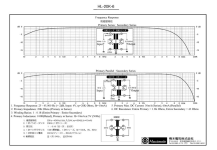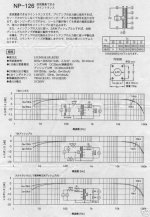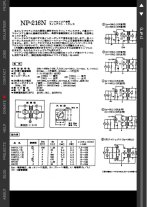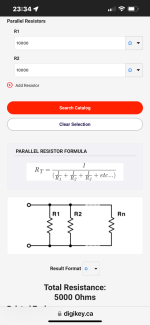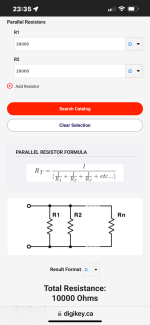Hello,
The original poster could decide to ask a moderator to close his thread.
No one is promoting stuff that can be bought at this very enterprise so no harm is being done.
Greetings, eduard
The original poster could decide to ask a moderator to close his thread.
No one is promoting stuff that can be bought at this very enterprise so no harm is being done.
Greetings, eduard
No need for that heavy handed step.
If he's getting good information that he will actually think about, then great. However, if he will only listen to that one person, we have wasted our time. But there is information here that can help others.
If he's getting good information that he will actually think about, then great. However, if he will only listen to that one person, we have wasted our time. But there is information here that can help others.
@anatech I agree with everything you said.
My requirement for balanced xlr is that my speakers are 25ft from my DAC and soon to be pre. And I have found with audio music gear wifi light system in my house throws a lot of noise to my guitar gear. And I have XLR studio monitors as my speaker system already.
This is what I’m using and want not what people are telling me to use or buy. When I switched my guitar gear on fractal audio modeling amp to XLR - zero noise from the lights.
The system I have now I built - a streamer and DAC and going XLR analogue out to my powered XLR speakers. I want to add a preamp to see how that changes the sound. Any many on the DAC forums recommend it.
Already getting some good input on now two types of output transformers. I haven’t bought those yet.
And maybe other newbies would like to follow a build? Totally open to input
My requirement for balanced xlr is that my speakers are 25ft from my DAC and soon to be pre. And I have found with audio music gear wifi light system in my house throws a lot of noise to my guitar gear. And I have XLR studio monitors as my speaker system already.
This is what I’m using and want not what people are telling me to use or buy. When I switched my guitar gear on fractal audio modeling amp to XLR - zero noise from the lights.
The system I have now I built - a streamer and DAC and going XLR analogue out to my powered XLR speakers. I want to add a preamp to see how that changes the sound. Any many on the DAC forums recommend it.
Already getting some good input on now two types of output transformers. I haven’t bought those yet.
And maybe other newbies would like to follow a build? Totally open to input
Hello,
So now we have to wait for someone who tried both the Hashimoto HL-20K-6 and the Iso/Tango NP126 and tell us there is no audible distance and the original poster should get the cheapest one.
The Iso website in Japan mentions a lower price than the Hashimoto available on Ebay.
The Tamura output transformers used by the Japanese man are available here on swapmeet but the type number in the add is wrong so a bit hard to find and they are 750 Euro for the pair and already been used.
Greetings, Eduard
So now we have to wait for someone who tried both the Hashimoto HL-20K-6 and the Iso/Tango NP126 and tell us there is no audible distance and the original poster should get the cheapest one.
The Iso website in Japan mentions a lower price than the Hashimoto available on Ebay.
The Tamura output transformers used by the Japanese man are available here on swapmeet but the type number in the add is wrong so a bit hard to find and they are 750 Euro for the pair and already been used.
Greetings, Eduard
How much gain do you need between the DAC and your amplifier?
Do you need it to be compatible with a turntable setup too?
Otherwise, if you are just concerned with distances, a "buffer" or "line stage" may be more appropriate.
But I also think you want to build a tube preamp and enjoy the experience. Luckily you are spoiled by an abundance of transformer choices at almost any price point you could imagine. It's certainly possible to buy several kinds, wire them up such that you can swap them in and out easily, then compare. Resell the other ones here or on eBay (or wherever!).
Do you need it to be compatible with a turntable setup too?
Otherwise, if you are just concerned with distances, a "buffer" or "line stage" may be more appropriate.
But I also think you want to build a tube preamp and enjoy the experience. Luckily you are spoiled by an abundance of transformer choices at almost any price point you could imagine. It's certainly possible to buy several kinds, wire them up such that you can swap them in and out easily, then compare. Resell the other ones here or on eBay (or wherever!).
Good question. I don’t currently need it for the gain, but understand this design will give me gain if I want or need it. I will plug my DAC into it. My DAC has multiple input sources. I2S, coax spidif, optical spidif. I have a streamer separate into the DAC over i2S. I will put a turntable into DAC via a separate pre-amp with optical out. The vinyl is a less used alternate source.
You are correct in that the experience of building a tube pre is a factor. As well as the fact many DAC fanatics are using different pres for reasons other than gain.
I’m also building a turntable. My goal is to have all custom built by me component system. I don’t know if I will get to speakers.
I am also a woodworker and make guitars. The case for DAC and tube pre will be mahogany and maple hardwood. Of course with copper inner case for pre.
This is such a cool world.
You are correct in that the experience of building a tube pre is a factor. As well as the fact many DAC fanatics are using different pres for reasons other than gain.
I’m also building a turntable. My goal is to have all custom built by me component system. I don’t know if I will get to speakers.
I am also a woodworker and make guitars. The case for DAC and tube pre will be mahogany and maple hardwood. Of course with copper inner case for pre.
This is such a cool world.
Here is my stage IV output board that is attached to the DAC I built. It is powered by a dual linear power supply to provide the differential voltage +5,0,-5 for the outputs.
Currently this is plugged straight into my Focal Audio A50 powered studio monitors via 20ft XLR cables. It can pretty much "blow out a match" now without any pre-amp. There is zero noise on it. I can play a silent test track at 0db full output from the Dual mono DACs and there is absolute silence with your ear right at the speaker. It's the best sound I've heard in my short life. I've got the DAC clocks powered by ultra capacitors. I've spent about $2500 on the DAC and Streamer half of it on power side of things and hi quality clocks. Every step of the way, I could hear the sound quality improve bu adding better power, better clocks, FIFO, etc.
The idea is to put the tube pre in between i) because I can and ii) because everyone says I am still missing something, and III) because it's an awesome project and I will learn a lot. it's the most "analogue" DAC i have had over past ten years (others were commercial Cambridge Audio units), but I still find some ever so slight harshness sometimes.......thus go tube for the final stage even if it is unity gain from the Output board below.

B. Features and specifications
This is why i need XLR ins and outs. Because I have them and like them and it's all I use for my music gear as well. And I need the distance and like the noise free sound over a long distance I need for my room layout and where my gear is located.
Currently this is plugged straight into my Focal Audio A50 powered studio monitors via 20ft XLR cables. It can pretty much "blow out a match" now without any pre-amp. There is zero noise on it. I can play a silent test track at 0db full output from the Dual mono DACs and there is absolute silence with your ear right at the speaker. It's the best sound I've heard in my short life. I've got the DAC clocks powered by ultra capacitors. I've spent about $2500 on the DAC and Streamer half of it on power side of things and hi quality clocks. Every step of the way, I could hear the sound quality improve bu adding better power, better clocks, FIFO, etc.
The idea is to put the tube pre in between i) because I can and ii) because everyone says I am still missing something, and III) because it's an awesome project and I will learn a lot. it's the most "analogue" DAC i have had over past ten years (others were commercial Cambridge Audio units), but I still find some ever so slight harshness sometimes.......thus go tube for the final stage even if it is unity gain from the Output board below.
B. Features and specifications
- Zero feedback
- OPA861 transconductance amplifiers work in two channels fully balanced configuration
- True current input mode with impedance less than10 ohms
- 80Mhz high bandwidth and 900V/us slew rate. This ultra-high speed performance would be great for an ESS DAC running by high frequency MCLK from 20MHz to 100MHz.
- Power supply: External +-5V power supplies
- Balanced output levels: 4VRMS @ 0dB
- Current input DC offset voltage: 1.65V
- High precision low noise thin film metal resistors
This is why i need XLR ins and outs. Because I have them and like them and it's all I use for my music gear as well. And I need the distance and like the noise free sound over a long distance I need for my room layout and where my gear is located.
Would I need the HL-10k-6 to get 5k/600ohms wired parallel primary?
Look at link. If I order outside EU from acoustic D, price is in yen (24800), which converts cheaper in USD than the $250USD from tubeusa site. I am in Canada!
But I would probably be hit with import tax in either case actually. Even when I order from USA I get zapped with 13% tax. Such is "free trade".

Look at link. If I order outside EU from acoustic D, price is in yen (24800), which converts cheaper in USD than the $250USD from tubeusa site. I am in Canada!
But I would probably be hit with import tax in either case actually. Even when I order from USA I get zapped with 13% tax. Such is "free trade".
Would I need the HL-10k-6 to get 5k/600ohms wired parallel primary?
Attachments
Read what it says below diagrams - primary impendance 20K ( primary in series ).... and this is what the first diagram shows - the dots are imporatant for phasing and therfore for wiring in parallel or series depending on what You need. Lower diagram is parallel wiring if Yoy look closely.
Hello,
He will need 5kohm so the lower diagram will fit. So 20K in series and 5k in parallel.
But Iso/ Tango datasheet np126 is mentioning 20K and 10K
And Tango np216 is talking about 20k or 5K
So we need the knowledge base on this website or someone with better eyes than an average Japanese technician.
Greetings,Eduard
He will need 5kohm so the lower diagram will fit. So 20K in series and 5k in parallel.
But Iso/ Tango datasheet np126 is mentioning 20K and 10K
And Tango np216 is talking about 20k or 5K
So we need the knowledge base on this website or someone with better eyes than an average Japanese technician.
Greetings,Eduard
Attachments
I looked up your powered speakers and don't see a published sensitivity spec. The 5687 will likely provide way too much gain at full blast. Something to consider will then be the quality and type of potentiometer in use for the preamp. You'll want something good so that you can have it turned down fairly low but not be impacted by balance/noise issues that are more common with cheaper pots.Here is my stage IV output board that is attached to the DAC I built. It is powered by a dual linear power supply to provide the differential voltage +5,0,-5 for the outputs.
Currently this is plugged straight into my Focal Audio A50 powered studio monitors via 20ft XLR cables. It can pretty much "blow out a match" now without any pre-amp. There is zero noise on it. I can play a silent test track at 0db full output from the Dual mono DACs and there is absolute silence with your ear right at the speaker. It's the best sound I've heard in my short life. I've got the DAC clocks powered by ultra capacitors. I've spent about $2500 on the DAC and Streamer half of it on power side of things and hi quality clocks. Every step of the way, I could hear the sound quality improve bu adding better power, better clocks, FIFO, etc.
The idea is to put the tube pre in between i) because I can and ii) because everyone says I am still missing something, and III) because it's an awesome project and I will learn a lot. it's the most "analogue" DAC i have had over past ten years (others were commercial Cambridge Audio units), but I still find some ever so slight harshness sometimes.......thus go tube for the final stage even if it is unity gain from the Output board below.
View attachment 1226082
B. Features and specifications
- Zero feedback
- OPA861 transconductance amplifiers work in two channels fully balanced configuration
- True current input mode with impedance less than10 ohms
- 80Mhz high bandwidth and 900V/us slew rate. This ultra-high speed performance would be great for an ESS DAC running by high frequency MCLK from 20MHz to 100MHz.
- Power supply: External +-5V power supplies
- Balanced output levels: 4VRMS @ 0dB
- Current input DC offset voltage: 1.65V
- High precision low noise thin film metal resistors
This is why i need XLR ins and outs. Because I have them and like them and it's all I use for my music gear as well. And I need the distance and like the noise free sound over a long distance I need for my room layout and where my gear is located.
I have never used anything but standard audio taper pots, so take this as just a general suggestion for an alternative:
https://glass-ware.stores.turbify.net/a5stat.html
You can customize the attenuation here. If you are using digital volume control via the DAC, this may work well. I've ordered from him before. There are plenty of other options, too.
Yes thank you for the idea.
I do have a good volume control on the dual ESS9038Q2Ms. It is supposed to be one of the best implementations. So option is to just not have it at 0db and send minus dbs to the pre. I will take a look at this control too..:
Anyone using DACs with tube pre amps??? What do you do?
I do have a good volume control on the dual ESS9038Q2Ms. It is supposed to be one of the best implementations. So option is to just not have it at 0db and send minus dbs to the pre. I will take a look at this control too..:
Anyone using DACs with tube pre amps??? What do you do?
Last edited:
Hmm. I thought this formulation would apply but maybe not. Two resistances in parallel??Hello,
He will need 5kohm so the lower diagram will fit. So 20K in series and 5k in parallel.
But Iso/ Tango datasheet np126 is mentioning 20K and 10K
And Tango np216 is talking about 20k or 5K
So we need the knowledge base on this website or someone with better eyes than an average Japanese technician.
Greetings,Eduard
Attachments
I think this is the only thing I have left to add to the discussion:
Building a preamp gives you the ability, at a later date, to replace your powered speakers with a pair of passive speakers and an amplifier. That amp could be solid state, it could be vacuum tube.
If you never make the leap to passive speakers + amp, however, I think it makes more sense to build a line stage. Obviously that's a pretty big curve ball at this point but it's true. You don't need gain; you just want some vacuum tube character introduced to the equation. Your powered speakers give you +6dB gain and I think that's a common range for a line stage, too.
If you intend to add headphone out, though, that is a strong argument for the project, all that said.
Look forward to seeing where it goes. Good luck!
Building a preamp gives you the ability, at a later date, to replace your powered speakers with a pair of passive speakers and an amplifier. That amp could be solid state, it could be vacuum tube.
If you never make the leap to passive speakers + amp, however, I think it makes more sense to build a line stage. Obviously that's a pretty big curve ball at this point but it's true. You don't need gain; you just want some vacuum tube character introduced to the equation. Your powered speakers give you +6dB gain and I think that's a common range for a line stage, too.
If you intend to add headphone out, though, that is a strong argument for the project, all that said.
Look forward to seeing where it goes. Good luck!
looked up your powered speakers and don't see a published sensitivity spec.
Hello to the city of Belgrado,Read what it says below diagrams - primary impendance 20K ( primary in series ).... and this is what the first diagram shows - the dots are imporatant for phasing and therfore for wiring in parallel or series depending on what You need. Lower diagram is parallel wiring if Yoy look closely.
Indeed in series 20k and parallel 5K at Hashimoto and Tangp np216 datasheet.
But at np126 they write 20 and 10 K .
I know that just like putting two 20H chokes in parallel will not give you ten but five H so it must be an error on the Np126 sheet.
Greetings,Eduard
- Home
- Amplifiers
- Tubes / Valves
- "Serious Pre" Tube Build
